An Analysis of Workplace Health and Safety: Regulations and Practices
VerifiedAdded on 2021/04/19
|9
|1979
|39
Report
AI Summary
This report examines workplace health and safety, addressing global statistics on occupational injuries and the importance of preventative measures. It outlines the German model of workplace safety, emphasizing state and insurance institute collaboration. The report details accessing information sources, health monitoring processes, and strategies for consultation with individuals and parties to identify and evaluate factors affecting worker health, including risks associated with asbestos exposure. It covers planning, development, implementation, and review of worker health and wellbeing measures, highlighting the need for information sharing and the role of consultation in encouraging individual involvement. Finally, the report underscores the significance of understanding health and safety legislation and workplace policies in ensuring compliance and promoting a safe working environment. The report references relevant legislation and research to support its findings.
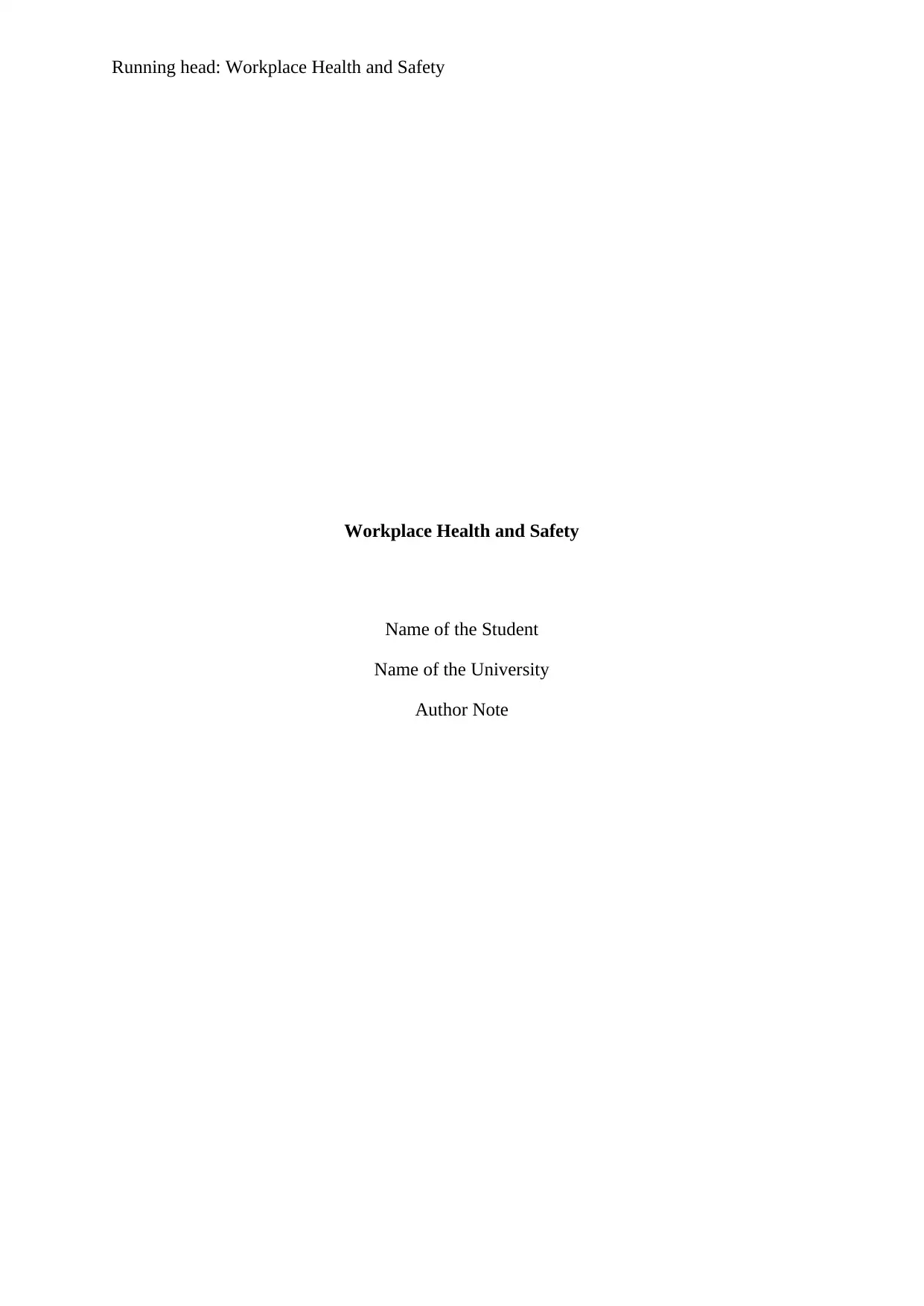
Running head: Workplace Health and Safety
Workplace Health and Safety
Name of the Student
Name of the University
Author Note
Workplace Health and Safety
Name of the Student
Name of the University
Author Note
Paraphrase This Document
Need a fresh take? Get an instant paraphrase of this document with our AI Paraphraser
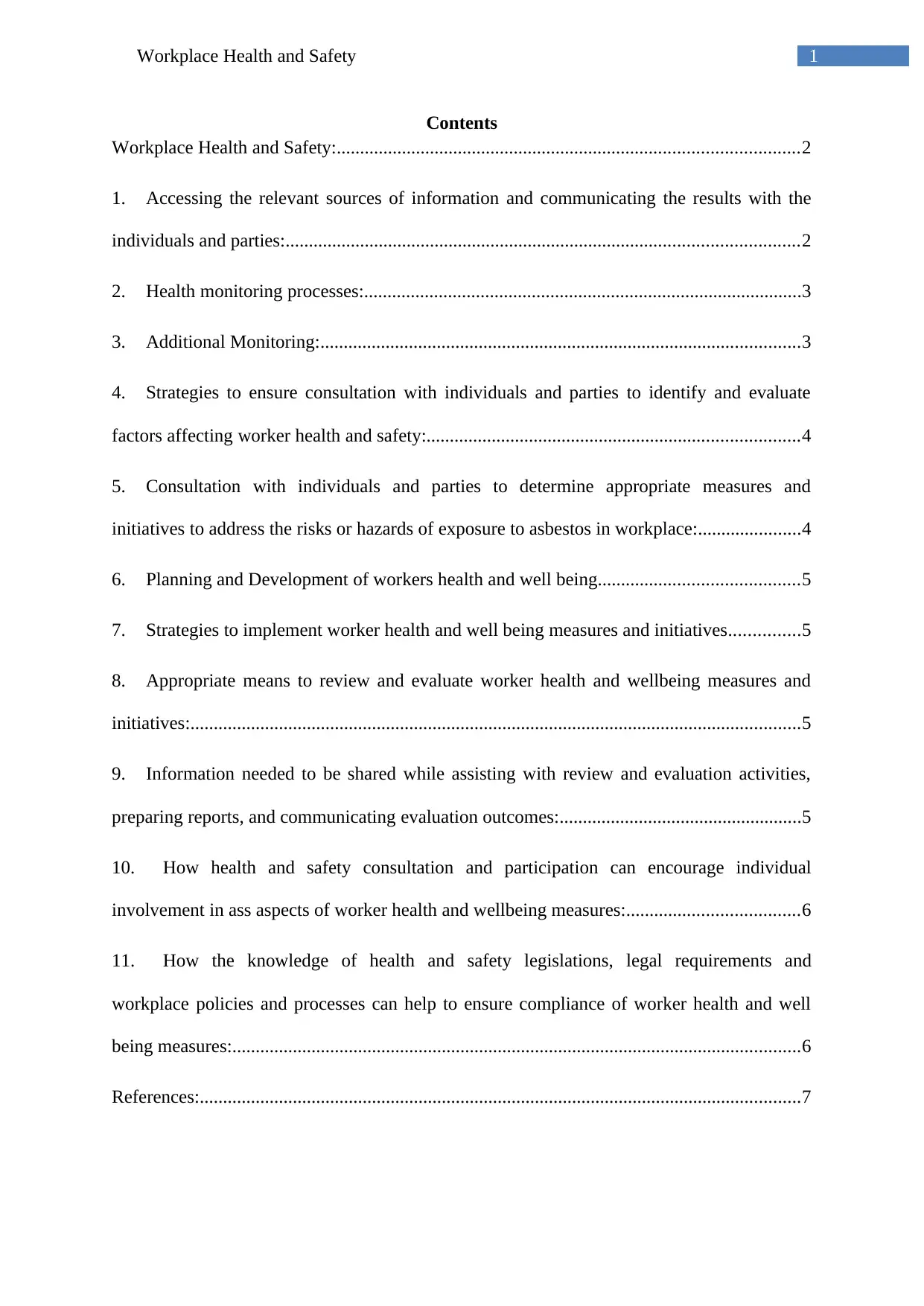
1Workplace Health and Safety
Contents
Workplace Health and Safety:...................................................................................................2
1. Accessing the relevant sources of information and communicating the results with the
individuals and parties:..............................................................................................................2
2. Health monitoring processes:..............................................................................................3
3. Additional Monitoring:.......................................................................................................3
4. Strategies to ensure consultation with individuals and parties to identify and evaluate
factors affecting worker health and safety:................................................................................4
5. Consultation with individuals and parties to determine appropriate measures and
initiatives to address the risks or hazards of exposure to asbestos in workplace:......................4
6. Planning and Development of workers health and well being...........................................5
7. Strategies to implement worker health and well being measures and initiatives...............5
8. Appropriate means to review and evaluate worker health and wellbeing measures and
initiatives:...................................................................................................................................5
9. Information needed to be shared while assisting with review and evaluation activities,
preparing reports, and communicating evaluation outcomes:....................................................5
10. How health and safety consultation and participation can encourage individual
involvement in ass aspects of worker health and wellbeing measures:.....................................6
11. How the knowledge of health and safety legislations, legal requirements and
workplace policies and processes can help to ensure compliance of worker health and well
being measures:..........................................................................................................................6
References:.................................................................................................................................7
Contents
Workplace Health and Safety:...................................................................................................2
1. Accessing the relevant sources of information and communicating the results with the
individuals and parties:..............................................................................................................2
2. Health monitoring processes:..............................................................................................3
3. Additional Monitoring:.......................................................................................................3
4. Strategies to ensure consultation with individuals and parties to identify and evaluate
factors affecting worker health and safety:................................................................................4
5. Consultation with individuals and parties to determine appropriate measures and
initiatives to address the risks or hazards of exposure to asbestos in workplace:......................4
6. Planning and Development of workers health and well being...........................................5
7. Strategies to implement worker health and well being measures and initiatives...............5
8. Appropriate means to review and evaluate worker health and wellbeing measures and
initiatives:...................................................................................................................................5
9. Information needed to be shared while assisting with review and evaluation activities,
preparing reports, and communicating evaluation outcomes:....................................................5
10. How health and safety consultation and participation can encourage individual
involvement in ass aspects of worker health and wellbeing measures:.....................................6
11. How the knowledge of health and safety legislations, legal requirements and
workplace policies and processes can help to ensure compliance of worker health and well
being measures:..........................................................................................................................6
References:.................................................................................................................................7
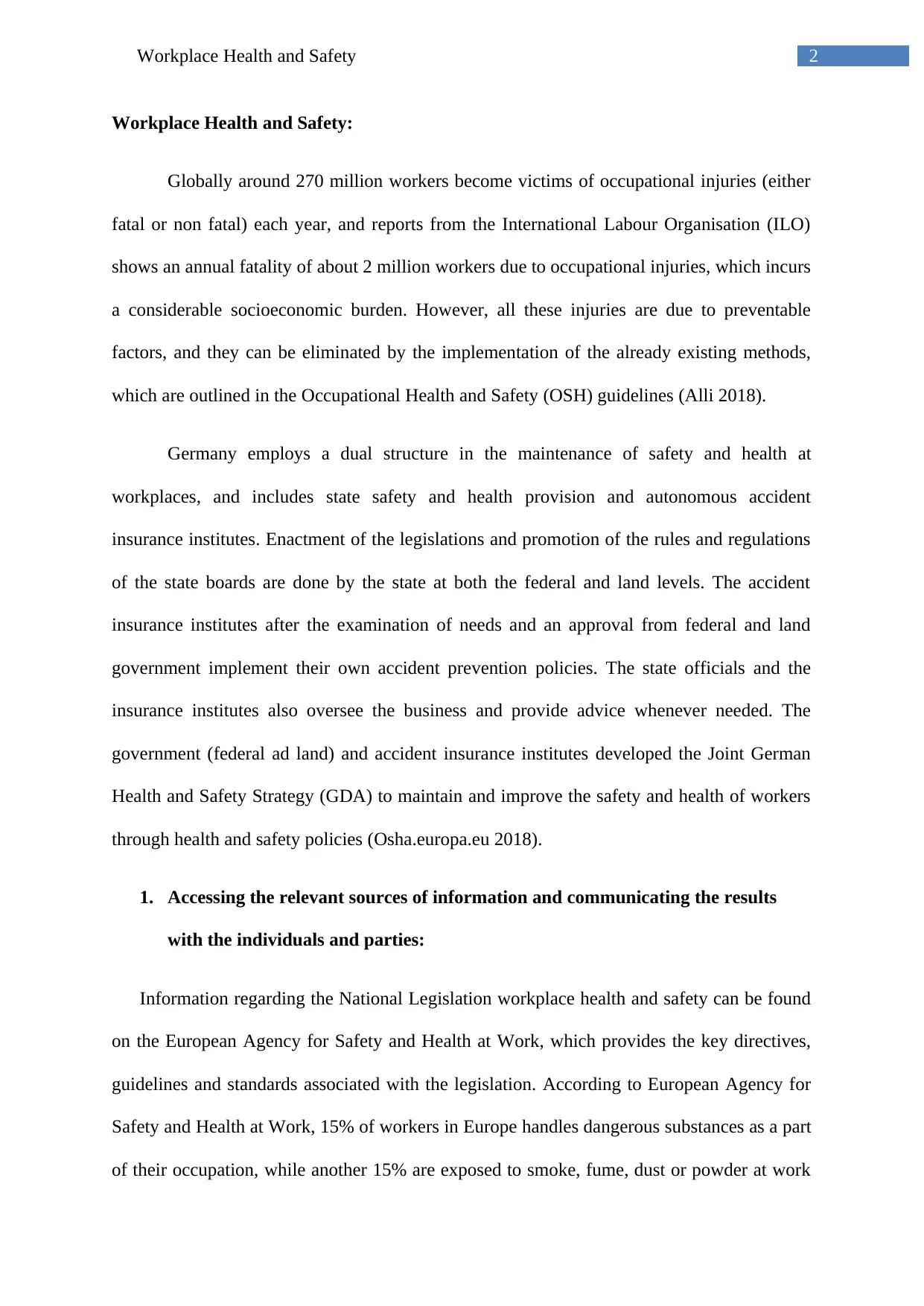
2Workplace Health and Safety
Workplace Health and Safety:
Globally around 270 million workers become victims of occupational injuries (either
fatal or non fatal) each year, and reports from the International Labour Organisation (ILO)
shows an annual fatality of about 2 million workers due to occupational injuries, which incurs
a considerable socioeconomic burden. However, all these injuries are due to preventable
factors, and they can be eliminated by the implementation of the already existing methods,
which are outlined in the Occupational Health and Safety (OSH) guidelines (Alli 2018).
Germany employs a dual structure in the maintenance of safety and health at
workplaces, and includes state safety and health provision and autonomous accident
insurance institutes. Enactment of the legislations and promotion of the rules and regulations
of the state boards are done by the state at both the federal and land levels. The accident
insurance institutes after the examination of needs and an approval from federal and land
government implement their own accident prevention policies. The state officials and the
insurance institutes also oversee the business and provide advice whenever needed. The
government (federal ad land) and accident insurance institutes developed the Joint German
Health and Safety Strategy (GDA) to maintain and improve the safety and health of workers
through health and safety policies (Osha.europa.eu 2018).
1. Accessing the relevant sources of information and communicating the results
with the individuals and parties:
Information regarding the National Legislation workplace health and safety can be found
on the European Agency for Safety and Health at Work, which provides the key directives,
guidelines and standards associated with the legislation. According to European Agency for
Safety and Health at Work, 15% of workers in Europe handles dangerous substances as a part
of their occupation, while another 15% are exposed to smoke, fume, dust or powder at work
Workplace Health and Safety:
Globally around 270 million workers become victims of occupational injuries (either
fatal or non fatal) each year, and reports from the International Labour Organisation (ILO)
shows an annual fatality of about 2 million workers due to occupational injuries, which incurs
a considerable socioeconomic burden. However, all these injuries are due to preventable
factors, and they can be eliminated by the implementation of the already existing methods,
which are outlined in the Occupational Health and Safety (OSH) guidelines (Alli 2018).
Germany employs a dual structure in the maintenance of safety and health at
workplaces, and includes state safety and health provision and autonomous accident
insurance institutes. Enactment of the legislations and promotion of the rules and regulations
of the state boards are done by the state at both the federal and land levels. The accident
insurance institutes after the examination of needs and an approval from federal and land
government implement their own accident prevention policies. The state officials and the
insurance institutes also oversee the business and provide advice whenever needed. The
government (federal ad land) and accident insurance institutes developed the Joint German
Health and Safety Strategy (GDA) to maintain and improve the safety and health of workers
through health and safety policies (Osha.europa.eu 2018).
1. Accessing the relevant sources of information and communicating the results
with the individuals and parties:
Information regarding the National Legislation workplace health and safety can be found
on the European Agency for Safety and Health at Work, which provides the key directives,
guidelines and standards associated with the legislation. According to European Agency for
Safety and Health at Work, 15% of workers in Europe handles dangerous substances as a part
of their occupation, while another 15% are exposed to smoke, fume, dust or powder at work
⊘ This is a preview!⊘
Do you want full access?
Subscribe today to unlock all pages.

Trusted by 1+ million students worldwide
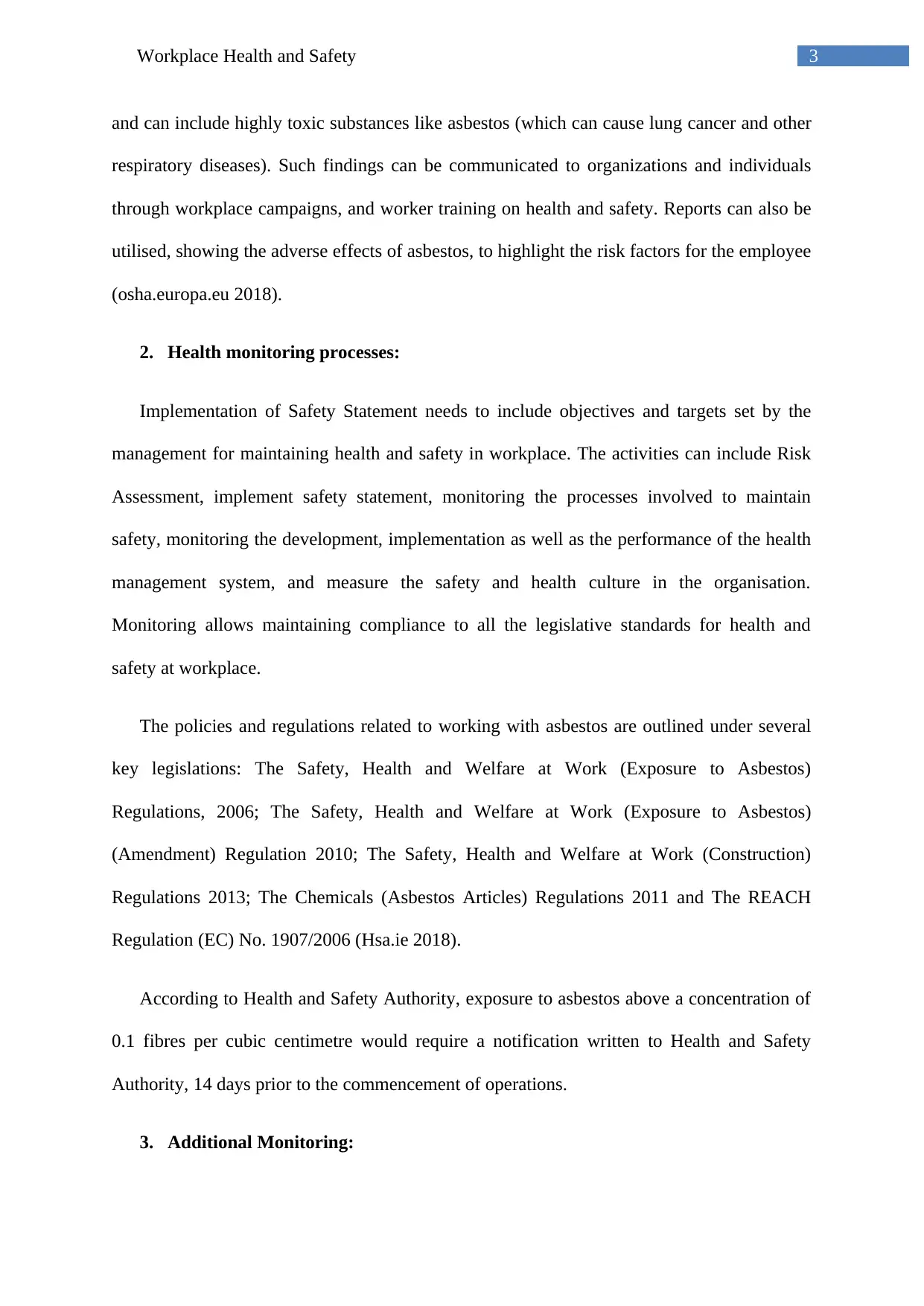
3Workplace Health and Safety
and can include highly toxic substances like asbestos (which can cause lung cancer and other
respiratory diseases). Such findings can be communicated to organizations and individuals
through workplace campaigns, and worker training on health and safety. Reports can also be
utilised, showing the adverse effects of asbestos, to highlight the risk factors for the employee
(osha.europa.eu 2018).
2. Health monitoring processes:
Implementation of Safety Statement needs to include objectives and targets set by the
management for maintaining health and safety in workplace. The activities can include Risk
Assessment, implement safety statement, monitoring the processes involved to maintain
safety, monitoring the development, implementation as well as the performance of the health
management system, and measure the safety and health culture in the organisation.
Monitoring allows maintaining compliance to all the legislative standards for health and
safety at workplace.
The policies and regulations related to working with asbestos are outlined under several
key legislations: The Safety, Health and Welfare at Work (Exposure to Asbestos)
Regulations, 2006; The Safety, Health and Welfare at Work (Exposure to Asbestos)
(Amendment) Regulation 2010; The Safety, Health and Welfare at Work (Construction)
Regulations 2013; The Chemicals (Asbestos Articles) Regulations 2011 and The REACH
Regulation (EC) No. 1907/2006 (Hsa.ie 2018).
According to Health and Safety Authority, exposure to asbestos above a concentration of
0.1 fibres per cubic centimetre would require a notification written to Health and Safety
Authority, 14 days prior to the commencement of operations.
3. Additional Monitoring:
and can include highly toxic substances like asbestos (which can cause lung cancer and other
respiratory diseases). Such findings can be communicated to organizations and individuals
through workplace campaigns, and worker training on health and safety. Reports can also be
utilised, showing the adverse effects of asbestos, to highlight the risk factors for the employee
(osha.europa.eu 2018).
2. Health monitoring processes:
Implementation of Safety Statement needs to include objectives and targets set by the
management for maintaining health and safety in workplace. The activities can include Risk
Assessment, implement safety statement, monitoring the processes involved to maintain
safety, monitoring the development, implementation as well as the performance of the health
management system, and measure the safety and health culture in the organisation.
Monitoring allows maintaining compliance to all the legislative standards for health and
safety at workplace.
The policies and regulations related to working with asbestos are outlined under several
key legislations: The Safety, Health and Welfare at Work (Exposure to Asbestos)
Regulations, 2006; The Safety, Health and Welfare at Work (Exposure to Asbestos)
(Amendment) Regulation 2010; The Safety, Health and Welfare at Work (Construction)
Regulations 2013; The Chemicals (Asbestos Articles) Regulations 2011 and The REACH
Regulation (EC) No. 1907/2006 (Hsa.ie 2018).
According to Health and Safety Authority, exposure to asbestos above a concentration of
0.1 fibres per cubic centimetre would require a notification written to Health and Safety
Authority, 14 days prior to the commencement of operations.
3. Additional Monitoring:
Paraphrase This Document
Need a fresh take? Get an instant paraphrase of this document with our AI Paraphraser
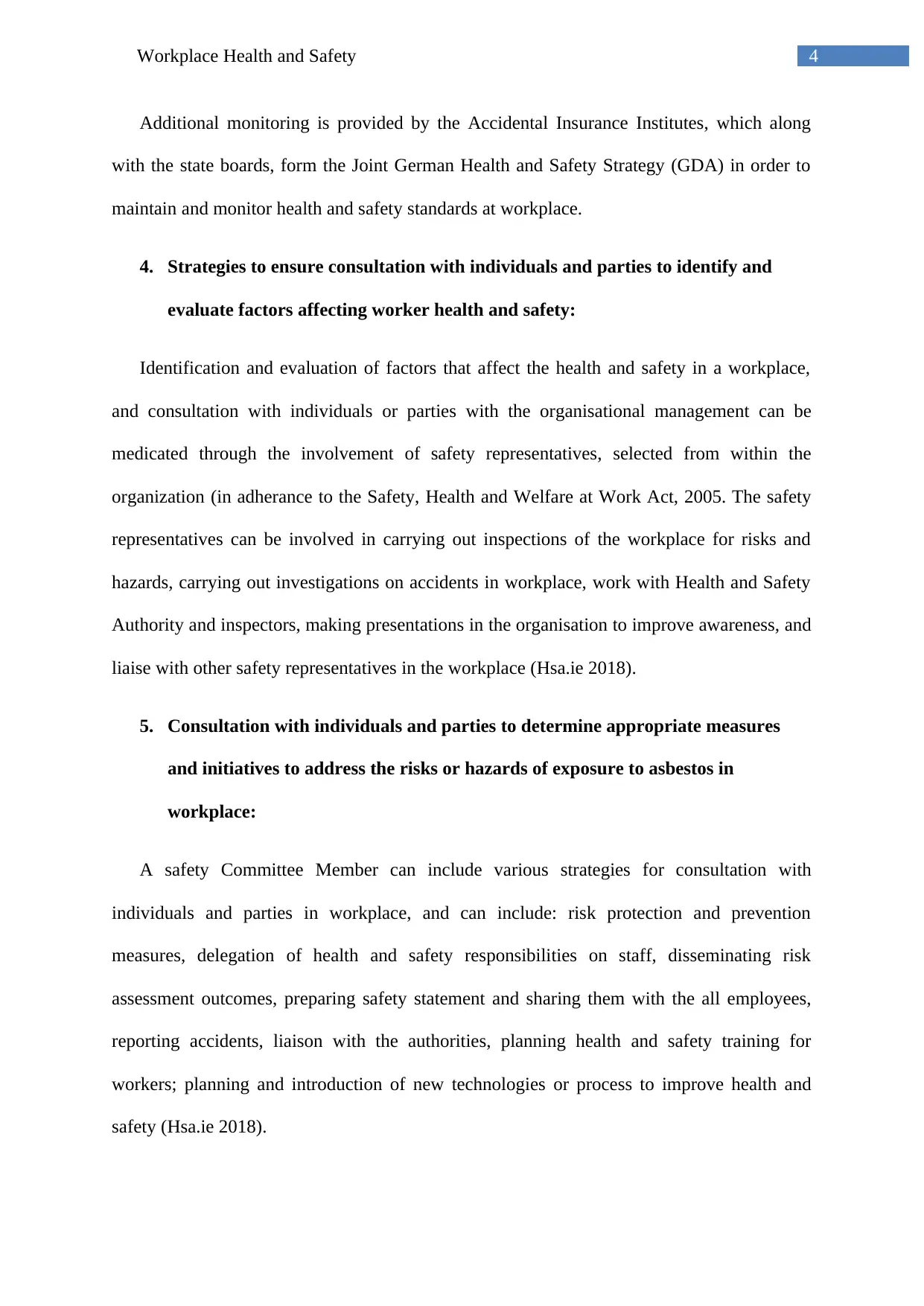
4Workplace Health and Safety
Additional monitoring is provided by the Accidental Insurance Institutes, which along
with the state boards, form the Joint German Health and Safety Strategy (GDA) in order to
maintain and monitor health and safety standards at workplace.
4. Strategies to ensure consultation with individuals and parties to identify and
evaluate factors affecting worker health and safety:
Identification and evaluation of factors that affect the health and safety in a workplace,
and consultation with individuals or parties with the organisational management can be
medicated through the involvement of safety representatives, selected from within the
organization (in adherance to the Safety, Health and Welfare at Work Act, 2005. The safety
representatives can be involved in carrying out inspections of the workplace for risks and
hazards, carrying out investigations on accidents in workplace, work with Health and Safety
Authority and inspectors, making presentations in the organisation to improve awareness, and
liaise with other safety representatives in the workplace (Hsa.ie 2018).
5. Consultation with individuals and parties to determine appropriate measures
and initiatives to address the risks or hazards of exposure to asbestos in
workplace:
A safety Committee Member can include various strategies for consultation with
individuals and parties in workplace, and can include: risk protection and prevention
measures, delegation of health and safety responsibilities on staff, disseminating risk
assessment outcomes, preparing safety statement and sharing them with the all employees,
reporting accidents, liaison with the authorities, planning health and safety training for
workers; planning and introduction of new technologies or process to improve health and
safety (Hsa.ie 2018).
Additional monitoring is provided by the Accidental Insurance Institutes, which along
with the state boards, form the Joint German Health and Safety Strategy (GDA) in order to
maintain and monitor health and safety standards at workplace.
4. Strategies to ensure consultation with individuals and parties to identify and
evaluate factors affecting worker health and safety:
Identification and evaluation of factors that affect the health and safety in a workplace,
and consultation with individuals or parties with the organisational management can be
medicated through the involvement of safety representatives, selected from within the
organization (in adherance to the Safety, Health and Welfare at Work Act, 2005. The safety
representatives can be involved in carrying out inspections of the workplace for risks and
hazards, carrying out investigations on accidents in workplace, work with Health and Safety
Authority and inspectors, making presentations in the organisation to improve awareness, and
liaise with other safety representatives in the workplace (Hsa.ie 2018).
5. Consultation with individuals and parties to determine appropriate measures
and initiatives to address the risks or hazards of exposure to asbestos in
workplace:
A safety Committee Member can include various strategies for consultation with
individuals and parties in workplace, and can include: risk protection and prevention
measures, delegation of health and safety responsibilities on staff, disseminating risk
assessment outcomes, preparing safety statement and sharing them with the all employees,
reporting accidents, liaison with the authorities, planning health and safety training for
workers; planning and introduction of new technologies or process to improve health and
safety (Hsa.ie 2018).
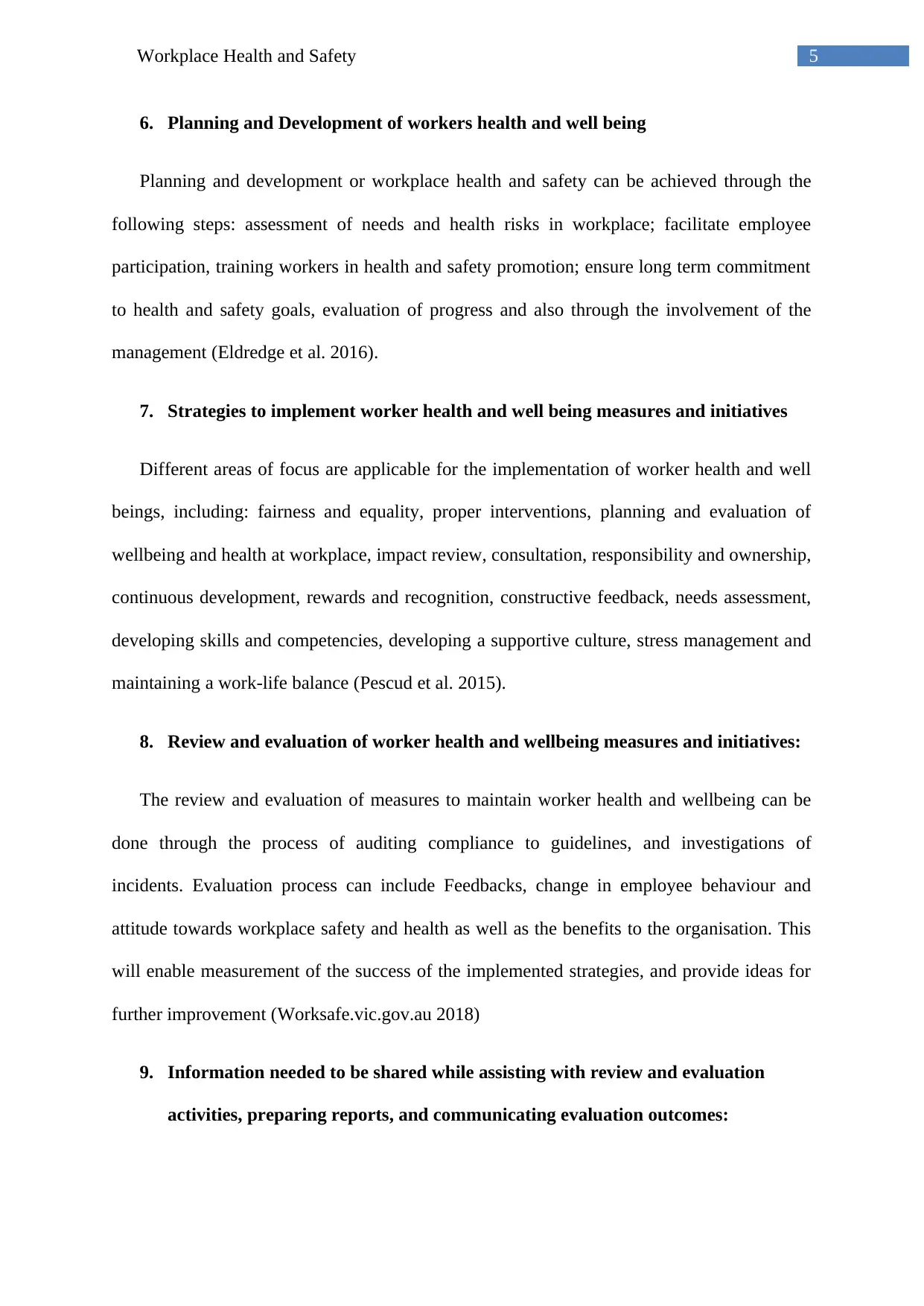
5Workplace Health and Safety
6. Planning and Development of workers health and well being
Planning and development or workplace health and safety can be achieved through the
following steps: assessment of needs and health risks in workplace; facilitate employee
participation, training workers in health and safety promotion; ensure long term commitment
to health and safety goals, evaluation of progress and also through the involvement of the
management (Eldredge et al. 2016).
7. Strategies to implement worker health and well being measures and initiatives
Different areas of focus are applicable for the implementation of worker health and well
beings, including: fairness and equality, proper interventions, planning and evaluation of
wellbeing and health at workplace, impact review, consultation, responsibility and ownership,
continuous development, rewards and recognition, constructive feedback, needs assessment,
developing skills and competencies, developing a supportive culture, stress management and
maintaining a work-life balance (Pescud et al. 2015).
8. Review and evaluation of worker health and wellbeing measures and initiatives:
The review and evaluation of measures to maintain worker health and wellbeing can be
done through the process of auditing compliance to guidelines, and investigations of
incidents. Evaluation process can include Feedbacks, change in employee behaviour and
attitude towards workplace safety and health as well as the benefits to the organisation. This
will enable measurement of the success of the implemented strategies, and provide ideas for
further improvement (Worksafe.vic.gov.au 2018)
9. Information needed to be shared while assisting with review and evaluation
activities, preparing reports, and communicating evaluation outcomes:
6. Planning and Development of workers health and well being
Planning and development or workplace health and safety can be achieved through the
following steps: assessment of needs and health risks in workplace; facilitate employee
participation, training workers in health and safety promotion; ensure long term commitment
to health and safety goals, evaluation of progress and also through the involvement of the
management (Eldredge et al. 2016).
7. Strategies to implement worker health and well being measures and initiatives
Different areas of focus are applicable for the implementation of worker health and well
beings, including: fairness and equality, proper interventions, planning and evaluation of
wellbeing and health at workplace, impact review, consultation, responsibility and ownership,
continuous development, rewards and recognition, constructive feedback, needs assessment,
developing skills and competencies, developing a supportive culture, stress management and
maintaining a work-life balance (Pescud et al. 2015).
8. Review and evaluation of worker health and wellbeing measures and initiatives:
The review and evaluation of measures to maintain worker health and wellbeing can be
done through the process of auditing compliance to guidelines, and investigations of
incidents. Evaluation process can include Feedbacks, change in employee behaviour and
attitude towards workplace safety and health as well as the benefits to the organisation. This
will enable measurement of the success of the implemented strategies, and provide ideas for
further improvement (Worksafe.vic.gov.au 2018)
9. Information needed to be shared while assisting with review and evaluation
activities, preparing reports, and communicating evaluation outcomes:
⊘ This is a preview!⊘
Do you want full access?
Subscribe today to unlock all pages.

Trusted by 1+ million students worldwide
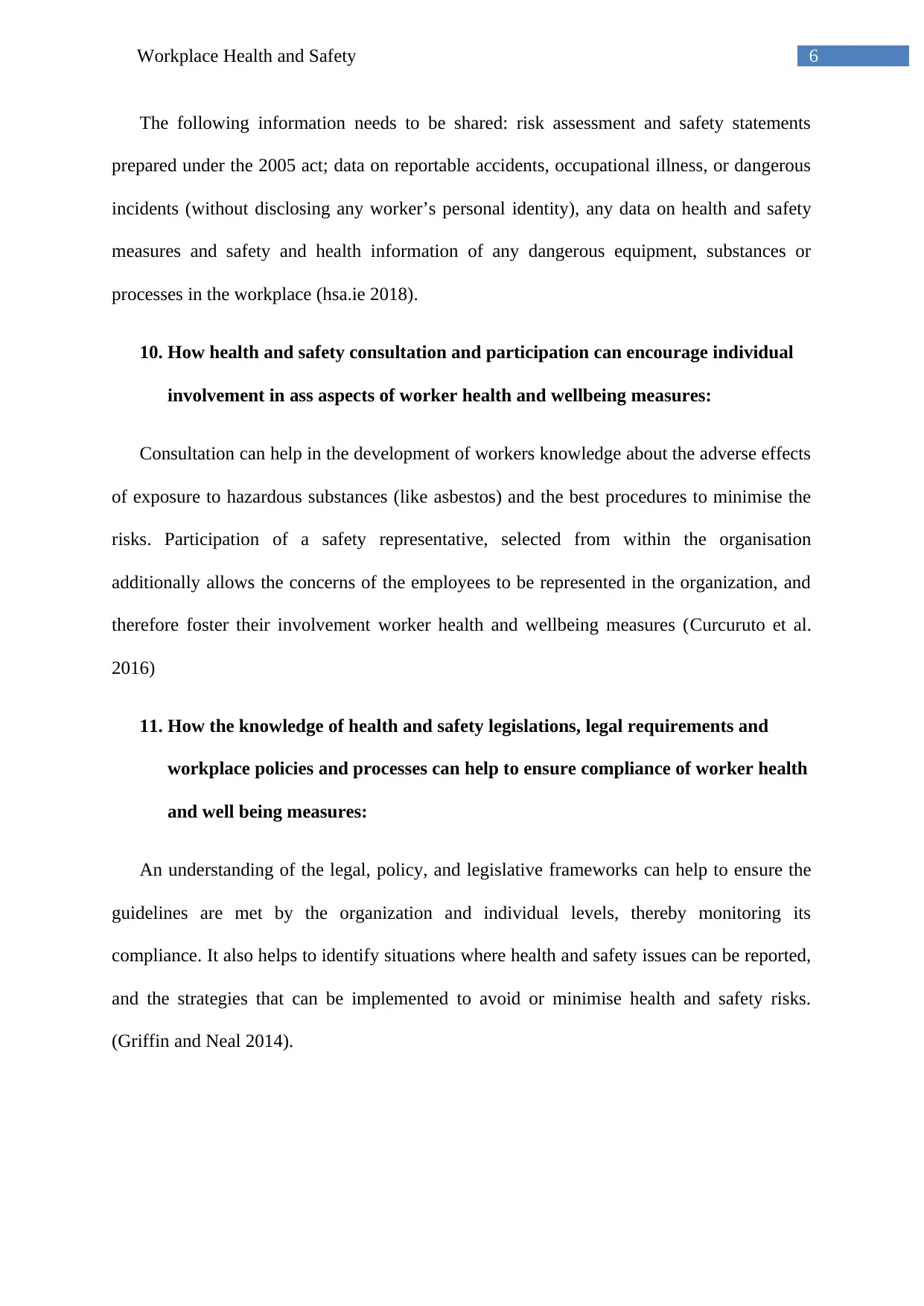
6Workplace Health and Safety
The following information needs to be shared: risk assessment and safety statements
prepared under the 2005 act; data on reportable accidents, occupational illness, or dangerous
incidents (without disclosing any worker’s personal identity), any data on health and safety
measures and safety and health information of any dangerous equipment, substances or
processes in the workplace (hsa.ie 2018).
10. How health and safety consultation and participation can encourage individual
involvement in ass aspects of worker health and wellbeing measures:
Consultation can help in the development of workers knowledge about the adverse effects
of exposure to hazardous substances (like asbestos) and the best procedures to minimise the
risks. Participation of a safety representative, selected from within the organisation
additionally allows the concerns of the employees to be represented in the organization, and
therefore foster their involvement worker health and wellbeing measures (Curcuruto et al.
2016)
11. How the knowledge of health and safety legislations, legal requirements and
workplace policies and processes can help to ensure compliance of worker health
and well being measures:
An understanding of the legal, policy, and legislative frameworks can help to ensure the
guidelines are met by the organization and individual levels, thereby monitoring its
compliance. It also helps to identify situations where health and safety issues can be reported,
and the strategies that can be implemented to avoid or minimise health and safety risks.
(Griffin and Neal 2014).
The following information needs to be shared: risk assessment and safety statements
prepared under the 2005 act; data on reportable accidents, occupational illness, or dangerous
incidents (without disclosing any worker’s personal identity), any data on health and safety
measures and safety and health information of any dangerous equipment, substances or
processes in the workplace (hsa.ie 2018).
10. How health and safety consultation and participation can encourage individual
involvement in ass aspects of worker health and wellbeing measures:
Consultation can help in the development of workers knowledge about the adverse effects
of exposure to hazardous substances (like asbestos) and the best procedures to minimise the
risks. Participation of a safety representative, selected from within the organisation
additionally allows the concerns of the employees to be represented in the organization, and
therefore foster their involvement worker health and wellbeing measures (Curcuruto et al.
2016)
11. How the knowledge of health and safety legislations, legal requirements and
workplace policies and processes can help to ensure compliance of worker health
and well being measures:
An understanding of the legal, policy, and legislative frameworks can help to ensure the
guidelines are met by the organization and individual levels, thereby monitoring its
compliance. It also helps to identify situations where health and safety issues can be reported,
and the strategies that can be implemented to avoid or minimise health and safety risks.
(Griffin and Neal 2014).
Paraphrase This Document
Need a fresh take? Get an instant paraphrase of this document with our AI Paraphraser
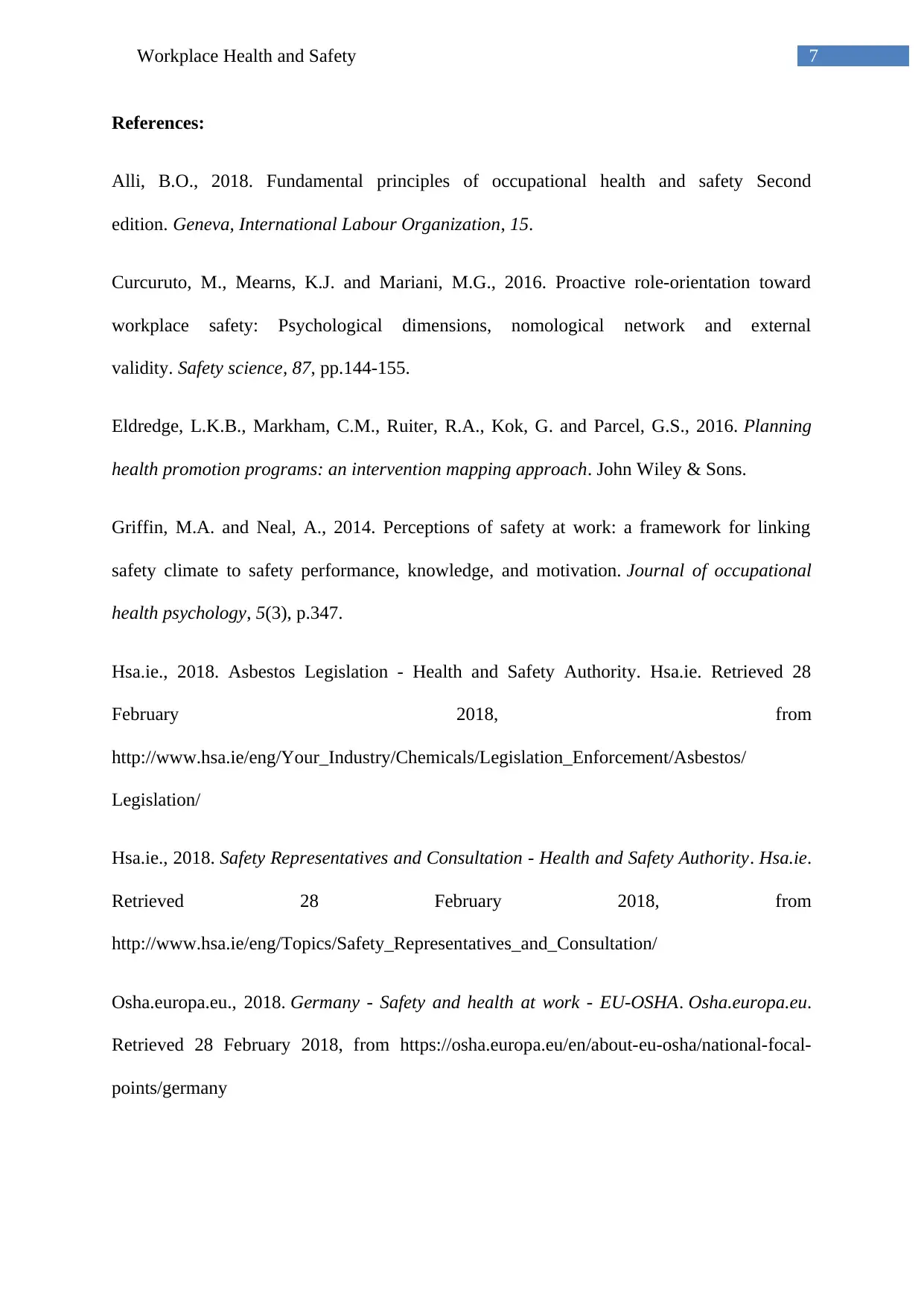
7Workplace Health and Safety
References:
Alli, B.O., 2018. Fundamental principles of occupational health and safety Second
edition. Geneva, International Labour Organization, 15.
Curcuruto, M., Mearns, K.J. and Mariani, M.G., 2016. Proactive role-orientation toward
workplace safety: Psychological dimensions, nomological network and external
validity. Safety science, 87, pp.144-155.
Eldredge, L.K.B., Markham, C.M., Ruiter, R.A., Kok, G. and Parcel, G.S., 2016. Planning
health promotion programs: an intervention mapping approach. John Wiley & Sons.
Griffin, M.A. and Neal, A., 2014. Perceptions of safety at work: a framework for linking
safety climate to safety performance, knowledge, and motivation. Journal of occupational
health psychology, 5(3), p.347.
Hsa.ie., 2018. Asbestos Legislation - Health and Safety Authority. Hsa.ie. Retrieved 28
February 2018, from
http://www.hsa.ie/eng/Your_Industry/Chemicals/Legislation_Enforcement/Asbestos/
Legislation/
Hsa.ie., 2018. Safety Representatives and Consultation - Health and Safety Authority. Hsa.ie.
Retrieved 28 February 2018, from
http://www.hsa.ie/eng/Topics/Safety_Representatives_and_Consultation/
Osha.europa.eu., 2018. Germany - Safety and health at work - EU-OSHA. Osha.europa.eu.
Retrieved 28 February 2018, from https://osha.europa.eu/en/about-eu-osha/national-focal-
points/germany
References:
Alli, B.O., 2018. Fundamental principles of occupational health and safety Second
edition. Geneva, International Labour Organization, 15.
Curcuruto, M., Mearns, K.J. and Mariani, M.G., 2016. Proactive role-orientation toward
workplace safety: Psychological dimensions, nomological network and external
validity. Safety science, 87, pp.144-155.
Eldredge, L.K.B., Markham, C.M., Ruiter, R.A., Kok, G. and Parcel, G.S., 2016. Planning
health promotion programs: an intervention mapping approach. John Wiley & Sons.
Griffin, M.A. and Neal, A., 2014. Perceptions of safety at work: a framework for linking
safety climate to safety performance, knowledge, and motivation. Journal of occupational
health psychology, 5(3), p.347.
Hsa.ie., 2018. Asbestos Legislation - Health and Safety Authority. Hsa.ie. Retrieved 28
February 2018, from
http://www.hsa.ie/eng/Your_Industry/Chemicals/Legislation_Enforcement/Asbestos/
Legislation/
Hsa.ie., 2018. Safety Representatives and Consultation - Health and Safety Authority. Hsa.ie.
Retrieved 28 February 2018, from
http://www.hsa.ie/eng/Topics/Safety_Representatives_and_Consultation/
Osha.europa.eu., 2018. Germany - Safety and health at work - EU-OSHA. Osha.europa.eu.
Retrieved 28 February 2018, from https://osha.europa.eu/en/about-eu-osha/national-focal-
points/germany
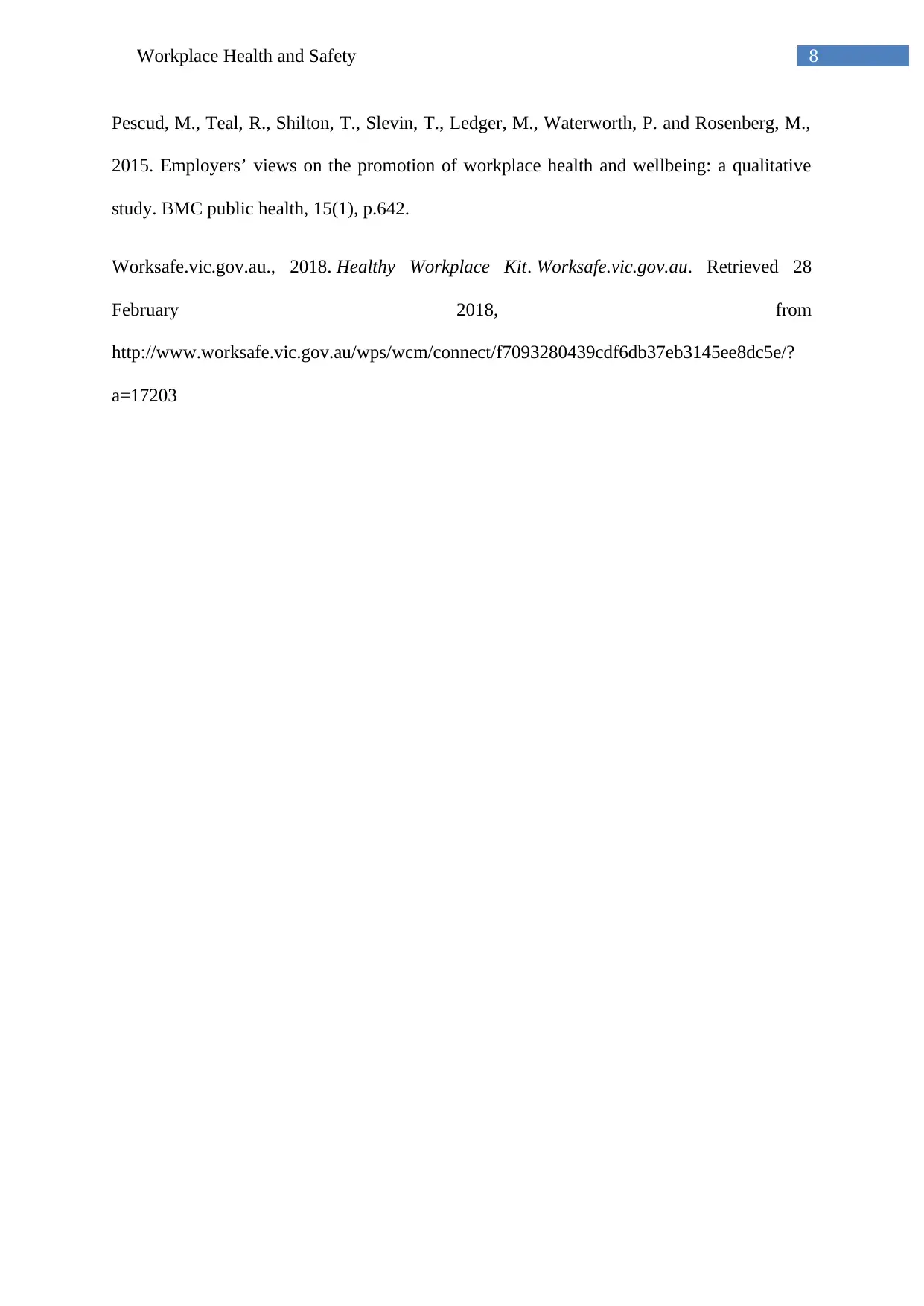
8Workplace Health and Safety
Pescud, M., Teal, R., Shilton, T., Slevin, T., Ledger, M., Waterworth, P. and Rosenberg, M.,
2015. Employers’ views on the promotion of workplace health and wellbeing: a qualitative
study. BMC public health, 15(1), p.642.
Worksafe.vic.gov.au., 2018. Healthy Workplace Kit. Worksafe.vic.gov.au. Retrieved 28
February 2018, from
http://www.worksafe.vic.gov.au/wps/wcm/connect/f7093280439cdf6db37eb3145ee8dc5e/?
a=17203
Pescud, M., Teal, R., Shilton, T., Slevin, T., Ledger, M., Waterworth, P. and Rosenberg, M.,
2015. Employers’ views on the promotion of workplace health and wellbeing: a qualitative
study. BMC public health, 15(1), p.642.
Worksafe.vic.gov.au., 2018. Healthy Workplace Kit. Worksafe.vic.gov.au. Retrieved 28
February 2018, from
http://www.worksafe.vic.gov.au/wps/wcm/connect/f7093280439cdf6db37eb3145ee8dc5e/?
a=17203
⊘ This is a preview!⊘
Do you want full access?
Subscribe today to unlock all pages.

Trusted by 1+ million students worldwide
1 out of 9
Related Documents
Your All-in-One AI-Powered Toolkit for Academic Success.
+13062052269
info@desklib.com
Available 24*7 on WhatsApp / Email
![[object Object]](/_next/static/media/star-bottom.7253800d.svg)
Unlock your academic potential
Copyright © 2020–2025 A2Z Services. All Rights Reserved. Developed and managed by ZUCOL.




